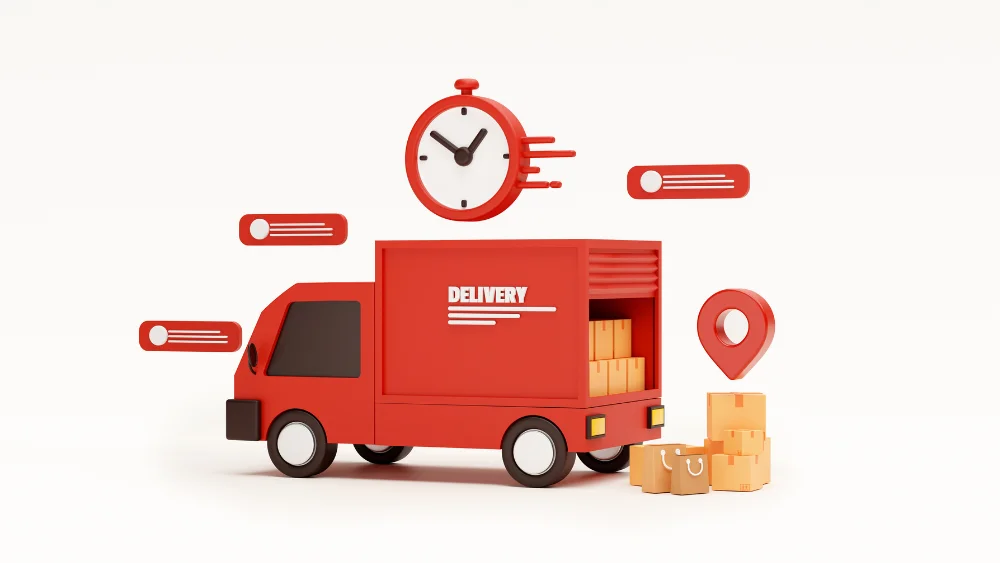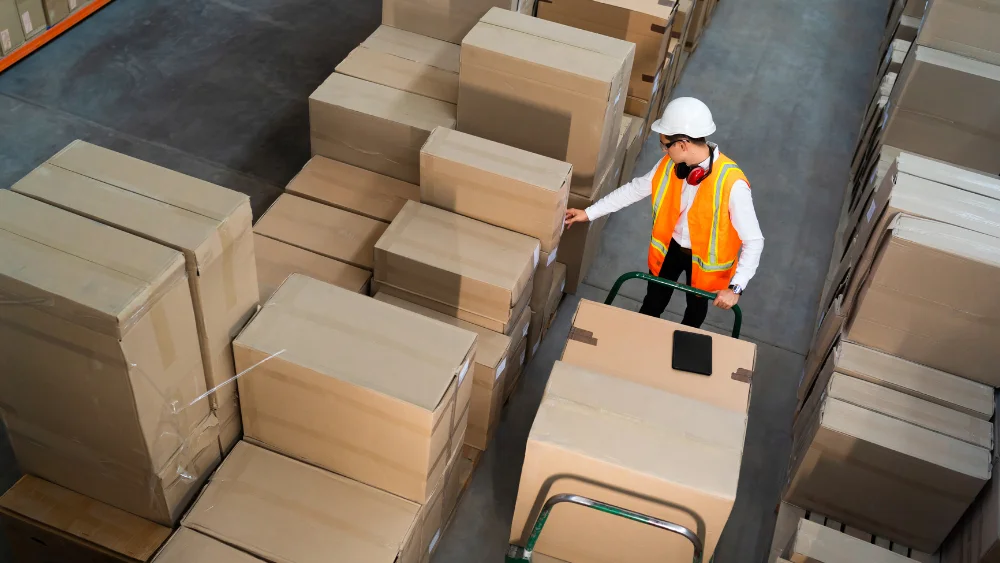In the competitive lingerie market, on-time delivery is key to success. Lingerie logistics, from shipping methods to customs clearance, plays a crucial role in ensuring products reach consumers promptly. Brands must navigate customs challenges and select the right logistics strategies to maintain their credibility and satisfy customer demand.
Table of Contents
The Importance of Lingerie Logistics in Ensuring Timely Deliveries
In today’s lingerie market, time is money, especially in an environment where competition is increasingly fierce. Every brand is vying for consumers’ attention, and the ability to deliver products on time often becomes the deciding factor. Whether or not a product arrives on schedule is not only crucial for smooth sales but also reflects the brand’s credibility. Delayed deliveries often mean missed opportunities and can even lead to customer dissatisfaction and damage to the brand’s image. One of the greatest challenges in this process is undoubtedly the logistics and customs barriers.
In a globalized world, lingerie brands are becoming increasingly reliant on international supply chains for production and distribution. However, cross-border shipping is inherently filled with complex variables. Every shipment faces numerous unknown risks: customs clearance delays, changing tariff policies, and even unforeseen issues during transit. These factors directly affect the delivery times of products, and consequently, the brand’s ability to respond to the market. For some brands that urgently need to launch new products or meet holiday demand, any form of delay can result in irreversible losses.
Therefore, timely delivery is not just an operational goal; it is a vital link of trust between the brand and the consumer, and the foundation for sustainable business development. Overcoming logistics and customs obstacles to ensure timely deliveries has become a critical strategic task for brands in this highly competitive market, highlighting the importance of effective lingerie logistics.
Choosing the Right Shipping Method in Lingerie Logistics

In the global supply chain, selecting the right shipping method is crucial for lingerie brands, especially when aiming for timely deliveries and controlling costs. Making the right decision can significantly affect the smooth operation of the entire process. In a complex international shipping environment, understanding the pros and cons of different shipping methods helps brands find the best balance between efficiency and cost.
Sea freight is undoubtedly one of the most economical shipping options. For bulk shipments, sea freight allows large-scale transportation at a very low per-unit cost. However, its disadvantages are quite apparent: the shipping cycle is long, ranging from several weeks to months, and there are numerous uncontrollable factors during transit, such as weather conditions or port congestion, which can lead to delays. As a result, sea freight is suitable for orders with large quantities and ample time buffers, but it’s not ideal for brands with tight delivery schedules.
In contrast, air freight is another common option that can significantly shorten transportation time, usually only taking a few days. However, the high costs associated with air freight make it unsuitable for long-distance transportation of bulk goods, especially for brands with limited budgets, where air freight costs can become a burden. Therefore, air freight is suitable for high-value or urgently needed orders, particularly during new product launches, seasonal promotions, or when meeting holiday demands.
Courier services are another flexible and fast shipping method, ideal for small batches and high-frequency orders. The cost lies between sea freight and air freight, but its flexible logistics network allows for faster delivery, making it especially convenient when handling samples or urgent orders.
The right shipping method depends on the urgency of the order, the budget, and the shipment volume. If a brand needs to respond quickly to market demand and the budget allows, air freight or courier services are ideal choices. For larger volumes with less time sensitivity, sea freight is more cost-effective. When making a decision, brands must consider these factors to ensure they meet customer needs while maintaining cost efficiency in their lingerie logistics.
Production Planning for Timely Delivery in Lingerie Logistics

In the lingerie industry, ensuring on-time delivery is not just a task; it is the foundation of brand reputation and customer trust. With global supply chains and complex production processes, how manufacturers precisely plan their production to avoid delivery delays has become a key factor in determining a brand’s success.
Precise Production Planning: The Key to Reducing Delays
The accuracy of production planning is first reflected in the full understanding and careful arrangement of order requirements. From the moment an order is received, manufacturers must strictly plan the timeline for every step, from fabric procurement and sample creation to large-scale production. By forecasting potential bottlenecks in the production process, such as fabric supply delays or machinery malfunctions, manufacturers can prepare adequately and reduce delays caused by unforeseen circumstances. Efficient lingerie logistics relies heavily on this precise planning to ensure timely delivery.
Real-Time Tracking and Communication: Maintaining Production Momentum
However, precise production planning is not a one-time solution—constant adjustments and updates are essential to maintaining progress. By using real-time tracking of production progress and effective communication with all parties involved, manufacturers can quickly identify issues during production and make adjustments. For example, modern production management systems can update the production process in real-time, ensuring every step follows the plan. Additionally, close communication with the brand is crucial. Regular updates and solving problems promptly help keep delivery expectations clear and avoid potential conflicts and uncertainties.
With such efficient production planning and smooth communication mechanisms, manufacturers not only complete production within the expected timeline but also build more trust and collaboration opportunities with the brand, ensuring that every delivery meets consumer expectations in lingerie logistics.
Navigating Customs Challenges: Ensuring Smooth Customs Clearance in Lingerie Logistics

In the complexity of global supply chains, customs clearance is undoubtedly a crucial step. For lingerie brands, ensuring smooth customs clearance is not only key to avoiding delays but also essential for maintaining a positive brand image. However, the various challenges within the customs process often catch many brands off guard. How to tackle these challenges and ensure that every batch of goods clears customs on time has become an integral part of a brand’s growth.
Common Customs Barriers and How to Overcome Them
Customs barriers can take many forms, with one of the most common being delays caused by inaccurate or incomplete documentation. Since customs policies vary from country to country, merchants may face clearance issues if they haven’t thoroughly researched the specific requirements of the destination country. Problems such as incomplete documents, incorrect product classification, or inaccurate value declarations can hinder customs clearance. Additionally, customs regulations often involve compliance checks, particularly for environmental and quality standards. Since lingerie is a product that directly touches the skin, failure to meet the required international standards can result in goods being detained or returned.
To avoid these issues, brands must collaborate with reliable suppliers and customs brokers to understand and prepare all necessary documents ahead of time. Regularly checking changes in customs regulations ensures that brands remain compliant with the latest requirements of the destination country.
Essential Documents: The Foundation for Smooth Customs Clearance
The core of smooth customs clearance lies in preparing all necessary documents. Some essential documents include:
- Commercial Invoice: This document lists the details of the goods, their value, and the seller and buyer information. Ensuring that the invoice is accurate, with price and quantity declarations matching reality, is the first step in avoiding clearance issues.
- Certificate of Origin: Many countries have specific requirements regarding the origin of imported products. Since lingerie often involves multi-country production chains, ensuring the accuracy of the certificate is crucial for avoiding tariff issues.
- Packing List: This document provides detailed information about the packaging, quantity, and size of the goods, helping customs verify the physical condition of the goods quickly.
- Other Compliance Documents: For some countries, compliance with environmental standards (such as OEKO-TEX certification) or safety standards is essential for clearance. This is especially important for markets with strict requirements for the materials, dyeing process, and chemical components of lingerie.
Ensuring that these documents are complete and accurate can significantly improve the efficiency of customs clearance, preventing unnecessary delays and additional costs. Moreover, good customs compliance not only facilitates smooth clearance but also enhances the brand’s reputation in international markets, establishing a professional brand image.
The Key to Smooth Customs Clearance
Navigating customs challenges and ensuring smooth clearance is not a one-time task. Brands need to work closely with professional customs brokers, master the customs policies of the destination countries, and meticulously prepare all necessary documents. Through this meticulous preparation, brands can avoid unnecessary delays and build trust and credibility in the international market. In lingerie logistics, good customs management is vital to maintaining operational efficiency and enhancing the brand’s global presence.
Managing Tariffs and Taxes in Lingerie Logistics

In cross-border procurement, tariffs are an inevitable factor. Particularly when importing lingerie products, changes in tariffs and their management often determine a brand’s profit margins. Effectively planning for tariff costs and employing strategies to reduce expenses has become a challenge every brand must face when expanding into international markets.
Tariff Expectations and Response: How to Plan for Costs
First and foremost, understanding tariff expectations is a key factor that cannot be overlooked in cross-border transactions. Different countries have varying tariff policies for imported goods, and lingerie products may face different rates. Brands must thoroughly research the tariff rates of each target market before making purchases. By accurately assessing the tariff situation in their target market, brands can budget accordingly and avoid price fluctuations caused by tariff changes. Additionally, correct product classification and applicable HS codes help brands avoid extra costs due to incorrect declarations.
Collaborating with the Right Manufacturer: Leveraging Trade Agreements and Free Trade Zones
Working with experienced manufacturers can greatly simplify tariff management. By partnering with these manufacturers, brands can gain a clearer understanding of trade agreements and free trade zone (FTZ) policies between the origin and destination countries. In some cases, these agreements allow brands to enjoy tariff reductions or exemptions, reducing import costs. Moreover, certain free trade zones offer options for tariff deferrals or reductions, helping brands further ease their financial burden. By working with the right partners, brands not only ensure effective tariff management but also lay a solid foundation for success in the global market.
Achieving Cost Control and Sustainable Growth in Lingerie Logistics
By adopting these strategies, brands can maintain product quality while better controlling costs, enhancing their market competitiveness, and ultimately achieving more stable and sustainable growth in the lingerie logistics sector.
Case Study: Simplifying Lingerie Logistics and Customs Processes
In the global market, how lingerie manufacturers efficiently manage logistics and customs processes to ensure on-time delivery is a significant challenge every brand faces. Take a well-known lingerie brand as an example; they successfully optimized every step of their supply chain by partnering with an experienced manufacturer. Firstly, the manufacturer established close partnerships with leading global logistics companies and achieved a balance between cost and time by choosing the appropriate shipping methods, such as a combination of air and sea freight. Secondly, the manufacturer utilized advanced real-time tracking systems, allowing them to monitor the location of goods and anticipate potential delays. This enabled them to proactively communicate with customers, avoiding unnecessary anxiety. Regarding customs clearance, the manufacturer, with a deep understanding of the policies and experience in various countries, ensured that all necessary documents were prepared in advance, accurately classified products, and quickly passed through customs, avoiding delays caused by complicated procedures. It was this comprehensive management of logistics and customs that ensured the brand’s on-time delivery and won the trust of the market.
Optimizing Lingerie Logistics and Customs Management for On-Time Delivery
From the analysis of the above case, we can see that optimizing logistics and customs management is crucial for ensuring on-time delivery for lingerie brands. First, brands must select manufacturers capable of handling complex logistics and customs matters, ensuring precise alignment between production schedules and delivery timelines. Secondly, accurate document preparation, flexible transportation options, and real-time communication mechanisms are key to avoiding delays. These factors not only guarantee timely arrival but also enhance the brand’s credibility in the eyes of consumers.
More importantly, choosing an experienced manufacturer helps brands quickly find solutions to logistics, customs, and tariff obstacles, reducing potential risks. An experienced partner can provide the necessary support and flexibility, allowing brands to focus on market expansion and customer service instead of getting bogged down by complex logistics and customs issues. Therefore, the manufacturer’s capabilities and cooperative synergy become critical to a brand’s success.

